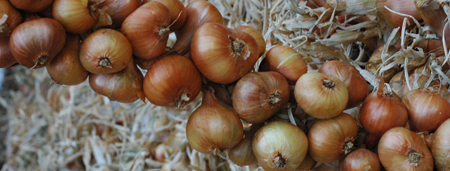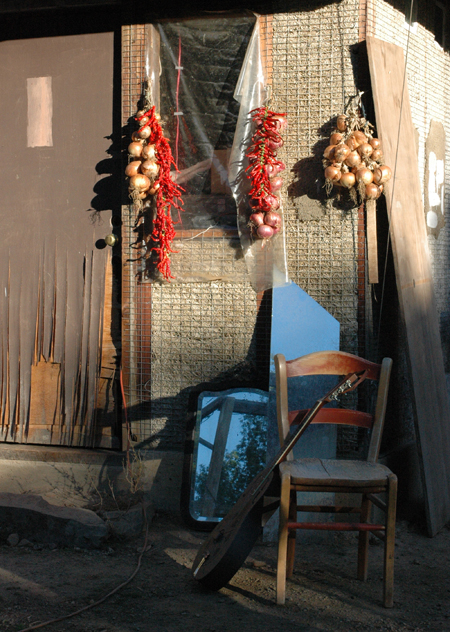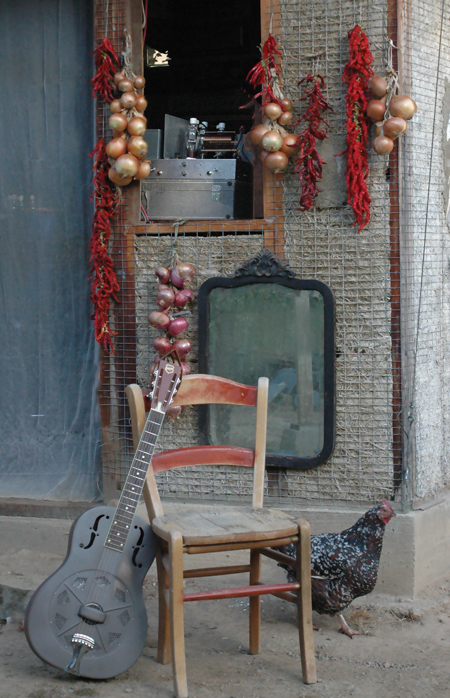 I often braid my onions, but my braids aren’t all neat and pretty-like. Stylish onion and garlic braids are nice, but I don’t have the time, energy and patience to sit around making something that I produce essentially for functional reasons look like I bought it at a country chic boutique. Last year though, we braided onions for the market. I spent a lot of time trimming the bulbs and making them look presentable, then dipping the dried leaves in water to re-soften so tonia could braid them neatly. We added dried lavender and stuff to spiff them up a bit. they turned out pretty nice and It was kind of fun, but it was also time consuming. A major motivator was that it allowed us to sell our onions for a lot more. If you really added up our time though, it was more like having another mediocre paying job to our lives, which is actually okay, but not high incentive. I liked our onions braids, but something never quite sat right about the whole thing. I think in a way we were diminishing the value of the food we grew by making it into something that may be viewed as art first and food second. Also, I couldn’t help thinking that we could have spent that time growing more food or making something more lasting.
I often braid my onions, but my braids aren’t all neat and pretty-like. Stylish onion and garlic braids are nice, but I don’t have the time, energy and patience to sit around making something that I produce essentially for functional reasons look like I bought it at a country chic boutique. Last year though, we braided onions for the market. I spent a lot of time trimming the bulbs and making them look presentable, then dipping the dried leaves in water to re-soften so tonia could braid them neatly. We added dried lavender and stuff to spiff them up a bit. they turned out pretty nice and It was kind of fun, but it was also time consuming. A major motivator was that it allowed us to sell our onions for a lot more. If you really added up our time though, it was more like having another mediocre paying job to our lives, which is actually okay, but not high incentive. I liked our onions braids, but something never quite sat right about the whole thing. I think in a way we were diminishing the value of the food we grew by making it into something that may be viewed as art first and food second. Also, I couldn’t help thinking that we could have spent that time growing more food or making something more lasting.
Braiding onions is actually more fun when I’m doing it for functional reasons. I just start slapping them together and it usually works out good enough ("Good enough", a lot of jokes have been made that this is the Turkeysong motto.) The braids are kind of messy, more like onion dreadlocks, but I’m looking at some of them hanging in my room right now and they’re pretty neat looking after they cure well enough to knock off some of the dirty outer skins. Once you give up on making them all perfect looking, curing and storing braided onions is very practical. It doesn’t take very long to whip out a 15 or 20 onion braid when you have no significant commitment to cosmetics. Functionally speaking, the bulbs in a braid have good air circulation for curing, and they don’t take up a lot of space like loose onions do when spread out somewhere to dry. You can easily move a braid in or out of the shade, and move them inside when it gets damp out. There is no picking up of numerous loose onions one at a time and finding another place to spread them out flat, or looking for a container with good air circulation to put them in. You can store the braids in a cool dry place, and maybe bring in one at a time to hang in the kitchen, pulling onions off as you need them. Some say the onions keep better because the necks are sealed and less likely to be infected with rot. If an onion does rot, it's less likely to infect others if it's not piled in with them several onions deep in a crate or bag, and they are much easier to inspect. Onion braiding is a great system and that’s why people started doing it. And yeah, it does look neat.
But it doesn't just look neat. To me it is also symbolic of my choices and my lifestyle. Each year, the sight of onion braids reinforces my sentiments about them and what they represent to me; my efforts of the past seasons carrying me through the coming ones.
Making pretty braids is much less functional. It takes a lot of time to clean up the bulbs so that they look good, and unless they've cured for a while, that process often leaves very little protective skin on the onions. There are also a certain number of losses when curing onions that are just inevitable. I’m sure that more than one person took one of our nice market braids home, at a cost of like 5 onions for 8.00 dollars, or whatever, and hung them up to look at them for so long that some of the onions rotted. I mean, that’s why you really buy a pretty onion braid, to look at it. And that’s kind of sad. Ideally, people would make the food I grow into art and eat it, not just look at it as art until it goes bad.
I’m not totally anti-pretty-onion-braid. For most people though, onions are a staple food, and braids are a great way to store onions. I remember thinking last year how cool it would be to sell more strictly functional onions braids. I don't think that quick braiding is at all cost prohibitive for me as a way to cure, store and market onions, and may in fact be more efficient for the reasons I already outlined. I just need enough onions to bother doing it. If I can find a solid keeper that looks and tastes good, with good cultural traits and all that stuff, and grow a big mess of them, I could sell people braids of 8 to 20 onions at an affordable per-pound price.
Many things and acts are symbolic, but not always of what we want them to be. I think we would do well to step sideways and try to look at what we want things to mean and to say about us, v.s. what they actually do. A nice onion braid can mean a lot of things. For us here, it was a chance to turn something we manifested from the soil into art of sorts. To give it more life. But another part of it, is that we were just profiting off people grasping at something that we have that they don’t, yet which they recognize as somehow valuable. They want to buy a polished up phenomenon of rural life and I'm pimping myself and my precious onions to sell it to them (okay, wait, that's an awesome image, the onion pimp. Gold chains, platform shoes...) I’m actually all for romanticizing country life a little. I just think that we would do well to extract and celebrate the best and most real parts of it, and not just a dressed up aesthetic. If someone hangs one of those braids up and thinks it's too cool and expensive to actually use, then that disrespects the food I've grown by placing the aesthetic above it's potential to nourish and enrich someones life in a more real way. But then, if my braid is all that nice, I'm just asking for it.
Depending on how my onions cure out this year, I may invest more in growing onions for market next year. They are a good crop in that they will keep between markets and can be sold all winter. That’s good. I need crops that hold and store well since I can’t make it down the hill to market every week. I sort of blew it this past season by getting my onions in too late, but some still did well (*see footnote on varieties and stuff below). I think it would be cool as hell to show up at the market with a pile of somewhat knobby functional onion braids; braids that aren’t so pretty that people won’t actually use the onions. You see what I’m getting at here? The symbol was real before, but now it means something different. It is symbolic of something more tangible and close to home; something that is not just playing at a fantasy of real food and farm, so much as participating in it as part of a rhythm of daily life. I grow onions. I braid them. You hang them in your kitchen and pluck them off to nourish your family. I see you at the market next year. And while you use them they visually reinforce the choices you’ve made and remind that food is maybe something more than a thing that shows up magically at the store and which you trade money for. I think that’s a pretty cool relationship.
I have a lot of stuff I’d like to do, and I don’t have the energy, space, fertilizer and water to make a real dent in the onion consumption of Ukiah residents, but I can make a tiny dent, and do it in a way that allows people to take home a more real, and more meaningful, piece of life here at Turkeysong. I’m sure I’ll get better at braiding and make prettier braids than I usually do. I might even braid in some dried flowers or some herb and chilis. But, I'm not sure I want them to be too pretty. The goal is definitely functionality and not adding a lot (if any) in price to what should be an affordable staple crop. If I want to make some serious stacks of cash, I can grow a couple beds of cipollini onions. Those flat little gems sell for 5.00 or 6.00 a pound to people who want to spend their money on gourmet food, which is great. What better could they spend it on?
these are just a few thoughts I’ve had over some time now. I woke up at 3:30 AM as I so often do. I put on my headlamp and did a little hoeing under the interstem apple trees in preparation for fall potato onion planting. Then I thought I’d use some of my time while waiting to get sleepy again bringing in the onion braids and chili strings that have been curing and drying on the south wall of the lizard house. I’ve been meaning to do it for a week or so. The onions cured nicely in the gentle sun we have this time of year (remember I planted late so I harvested late), and only one bulb was lost to rot so far. Now it’s almost dawn and I have to go back to sleep so I can wake up all perky and replace the head gasket on my car. And you probably thought I was going to go plough a field with a wooden stick or something like that. Gotta have a way to get the giant pile of onion braids I’ll have next year down the hill somehow. They’re not going to hike down there by themselves. Take my advice and stick to urban homesteading unless you have some other reason to be out in the country other than that it’s pretty and private. That way you can probably get your onion braids to market without a car.
Oh yeah, how do you do it!? It seems to work better for both curing and braiding if the greens are not too green. I think it’s actually better if they are mostly dry, but I’m still deciding what I can get away with. If they are very green, they shrink a lot in drying and the braid can become loose or even fall apart. Dip dried leaves in water briefly to make them more supple. Form an X with the leaves of two onions. Lay the leaves of a third onion over the cross formed by the X and wrap it’s leaves once around the cross' intersection to secure the first two onions in place Then you just start braiding, adding an onion with every lay over. putting in a piece of twine toward the end can help strengthen the top of the braid. I usually braid out to the tips and then double the end over and lash it down to form a loop for hanging. If none of that makes any sense, just do a search for onion braiding. There are plenty of tutorials out there. I’m out of onions to do a photo series with this year.
These french onion sellers, known in England as Onion Johnnies, wrap their onions on a core of straw or rushes instead of braiding, but the bulbs are already fully cured out. Actually, this whole onion johnny phenomenon is really an interesting study. From what I've gathered (which should be suspect:) they found it cheaper, easier and more profitable to import their onions to England across the channel and sell them there door to door, rather than trying to get them to French population centers. Apparently the onion Johnnies were quite the phenomenon for a long while, but then slowly stopped coming till there were only a few left. The onions are sold in hanks door to door. If you look at the older pictures of the Onion Johnnies, the hanks are very nice looking, but pretty plain. There is currently a revival, but this time it's a little different. There are festivals and stuff and you'll see a lot of the onion shanks are very dressed up with flowers and grain heads and stuff. I think that people probably used to buy them mostly for the onions. Now, it's probably more of an idea and a symbol that people are buying. It is even alleged that the stereotype of the frenchman in stripped shirt and beret came from the English being familiar with these guys. Now at the festivals the guys wear the hat and demonstrate spinning up shanks of onions for sale. They have to sell their frenchness a little. I like to dress up my booth and I sell ideas like heirlooms and the more aesthetic parts of life here. It's an interesting thing to think about though, when are we degrading and pimping ourselves and over inflating an image, v.s. presenting an idea and aesthetic that will move people in a positive way while still making fat stacks of cash :O So here is the idealized version, though still maybe kind of squalid. I stopped short of finishing the building...
*variety and growing notes: Yellow of Parma from baker creek is looking very nice. It’s a round uniform onion and looks like a good keeper type, though we'll see about that. Most of the other onions I’ve trialed from baker creek did poorly, and many have had a tendency toward bifurcation. bifurcation is when the bulb divides internally into two or more bulbs with a papery sheath between them. They are harder to process and don't always keep as well as solid bulbs. The french braiding onion I bought from Baker Creek, Jaune Paille Des Vertus, and the German Storage oinion Stuttgarter, both had a high percentage of bifurcated bulbs. I met some folks from Sustainable Seed Company, who are based locally here. One of them was saying that bifurcation is a huge problem for them when trying to source quality seed. Seed growers make a lot more money if they plant a crop and just let it all go to seed. What they should be doing though is getting out in the fields and rigorously rouging out (killing) the “off types”. If they don’t, the seed quality runs down over a few generations. Borrettana Cipollini seed from Fedco and sustainable seed company is very nice and uniform, making cute, flat little onions with very little bifurcation. They look great braided, but I'm not sure how well they keep yet. I just ate some Borrettana Cipollini slow cooked in some killer turkeysong chicken broth with sage, bay, salt, pepper and dried black trumpets. All day cooked in the solar oven till the broth was reduced to the rich yellow fat. All I can say is, oh my fucking (lack of) god. Okay, I can also say sweet, fine textured, no sharpness, and wish I had some toasted bread to smash them on and a pint of guinness.
For you locals, I've had really good luck starting onions from seed in January to February. My target date is January 15th, but then through anytime in February seems to work well enough. I don't think I had a single seedling onion bolt this year, and that lack of seeding out is pretty much the norm when growing from seed. Seeding is common though when using starts that are grown somewhere else and shipped in, or especially planting those tortured little onion bulbs called sets. One market grower told me she only grows Candy onions because it's the only variety that doesn't bolt on her; but that's probably because she buys starts instead of starting them herself. Candy is a delicious onion though. I plan to start experimenting with some fall planting as well to see how that works for getting an early crop.







